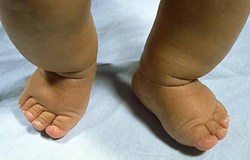Foot, Short
Definition:

Foot, Short
Objective: A measured foot length that is more than 2 SD below the mean for a newborn of 27-41 weeks gestation OR A foot that is less than the 3rd centile for individuals from birth to 16 years of age
Subjective: A foot that appears disproportionately short
Comments: Note that for females over the age of 16 years, the curves are essentially flat by 15 years of age, so the 16-year-old norms and distribution can be used for older individuals [Anderson et al., [1956]; Hall et al., [2007]]. However, the male norms still show significant growth at 16 years, where the graph ends. Therefore, only subjective assessments can be made for older males. For infants, the norms are specified in SD, per the primary source [Merlob et al., [1984]]. Foot length includes the relatively long calcaneus and tarsal bones as well as the metatarsals and first toe, and so the hand and foot measurements may reflect different growth abnormalities. Foot length should be interpreted with caution if the individual has either Pes cavus or Pes planus.
COMMENTS (0) | Add Comment









